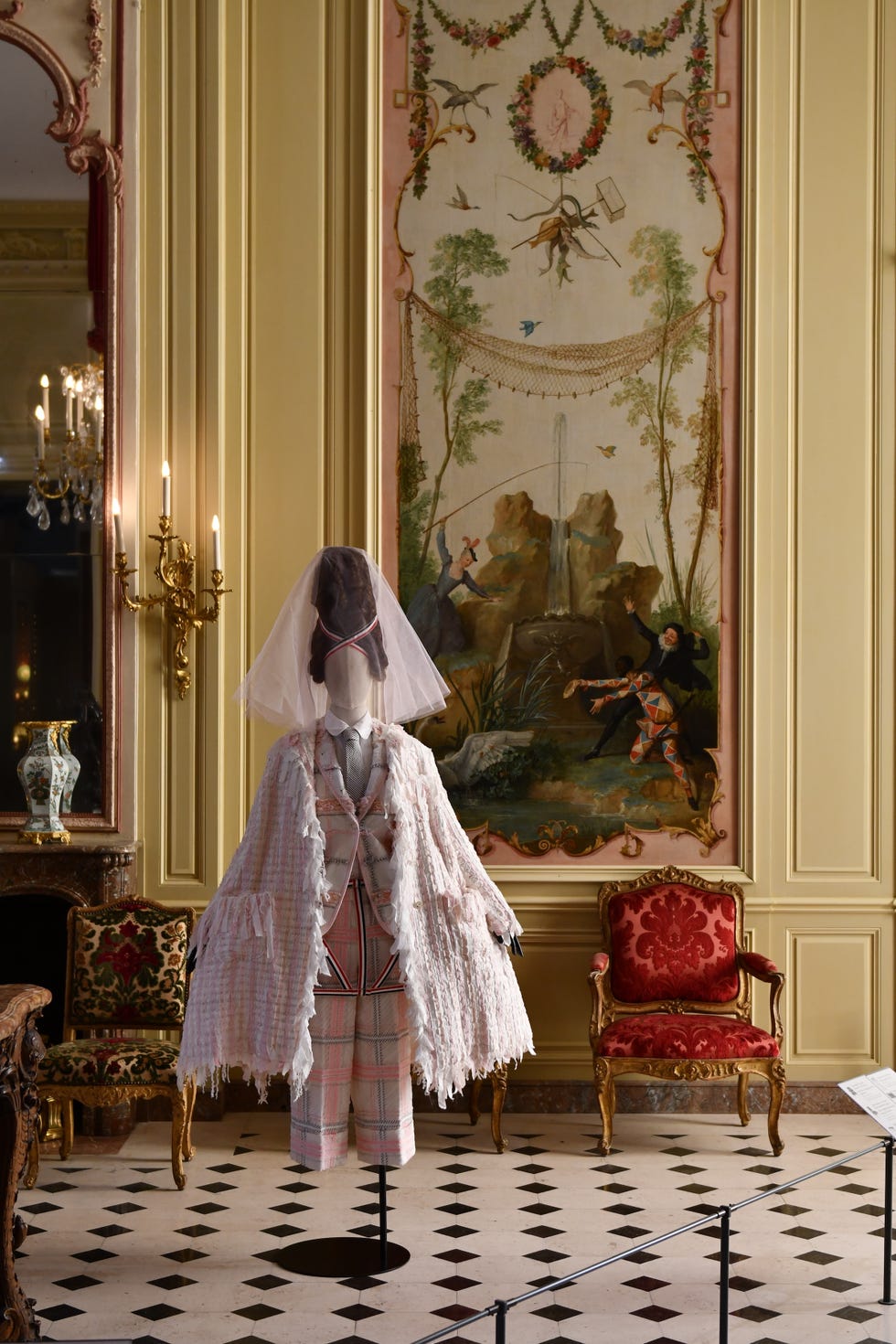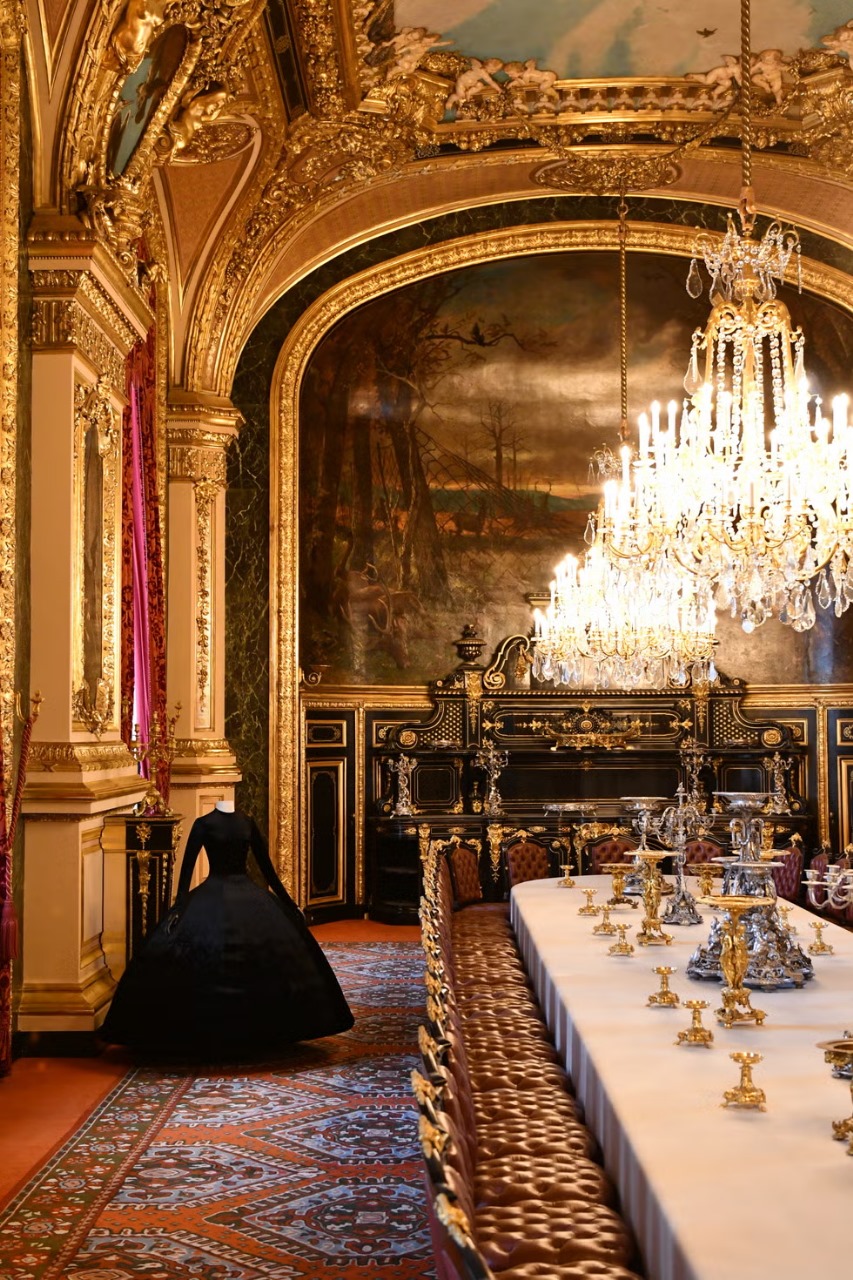Olivier Gabet, Director of the Department of Decorative Arts at the Louvre Museum, knows exactly what you’re thinking. When it was announced that the Louvre would host its first-ever fashion exhibition, Louvre Couture: Art and Fashion: Statement Pieces, in January 2025, with a fundraising gala to follow in March, it was impossible not to compare it to the Metropolitan Museum of Art’s iconic Costume Institute exhibition and the Met Gala. “The Costume Institute has a massive, credible fashion collection, so what we’re doing is a different story,” says Gabet, acknowledging that the Louvre does not have a department dedicated to fashion.
So, what role does fashion have at a museum that lacks a fashion department? “It needs to be connected to the Louvre’s collection. You want to spark new dialogues, but they must be relevant,” explains Gabet, who curated Louvre Couture with exhibition assistant Marie Brimicombe. The exhibition, open through July 21, showcases how historical art, objects, and styles have inspired 45 of the world’s leading fashion designers and maisons, displayed across 9,000 square meters of the Department of Decorative Arts galleries. Designers range from French icons like Chanel, Dior, and Givenchy to international names such as Prada, Erdem, Dries Van Noten, and Undercover, as well as avant-garde talents like Marine Serre and Charles de Vilmorin.

“It’s important to see fashion elevated to the highest level at some of the greatest museums in the world,” says American designer and CFDA Chairman Thom Browne, whose spring-summer 2020 ready-to-wear collection, inspired by 18th-century panniers, is complemented by whimsical Regency-era painted panels in the Louvre’s Isaac de Camondo period room. “It’s even more important that people visiting these institutions get to see the amazing work that so many of us have the privilege of experiencing in person.”
The exhibition, which features about 100 looks and accessories, includes loans from brand archives and heritage departments (with two exceptions: the Alaïa Foundation and the Yves Saint Laurent Museum). “It was important to showcase more than just haute couture because that’s no longer the only narrative of fashion,” says Gabet, noting the inclusion of contemporary fashion since 1960. “Contemporary fashion doesn’t have the same constraints as historical pieces, and can, perhaps, surprise our visitors more.”
While Louvre Couture allowed Gabet to tap into his sartorial expertise, honed during his nine years as Director of the Musée des Arts Décoratifs (MAD), his main goal was to engage a younger audience with his department’s wide array of decorative objects, which span from the Middle Ages to France’s Second Empire. “Fashion is universal and accessible,” Gabet notes, and can serve as a “bridge” to classical culture.

Nevertheless, Gabet rejects the idea that a fashion exhibition is just an easy crowd-pleaser. “We don’t need more visitors,” he says—the Louvre is the world’s most-visited museum. “It’s about offering another experience to our visitors.”
This sentiment is shared by Louvre Director Laurence des Cars, with whom Gabet worked at the Louvre Abu Dhabi in 2009 when they made the museum’s first acquisition—pieces from Yves Saint Laurent and Pierre Bergé’s collection—marking the beginning of their shared interest in the intersection of fashion and art. In 2022, they presented a small selection of Yves Saint Laurent garments alongside the Louvre’s permanent collection, a precursor to Louvre Couture.
Gabet’s vision for the exhibition has received full support from his colleagues, many of whom contributed reflective essays to the exhibition catalogue and participated in interviews for an upcoming documentary on the show. This interdisciplinary approach, merging scholarly and creative perspectives, is central to Gabet’s curatorial philosophy. “This is the point of view I wanted to develop in the exhibition,” he says.

Louvre Couture excels through its blending of old and new, and its collective respect for exquisite craftsmanship. “Andrew Bolton’s work is very inspirational to me,” says Gabet, referring to the curator of the Costume Institute’s major cross-departmental shows. Louvre Couture brings together the awe-inspiring scale of Heavenly Bodies: Fashion and the Catholic Imagination (2018), the immersive spectacle of China: Through the Looking Glass (2015), and the period-room experience of Dangerous Liaisons: Fashion and Furniture in the Eighteenth Century (2004), creating a significance that only the Louvre could achieve.
The scenography, designed by Nathalie Crinière (who also curated MAD’s Schiaparelli and Iris van Herpen exhibitions), had to reflect the Louvre’s style: “Everything is extraordinary at the Louvre, but with a simple, refined language,” says Gabet. “The Louvre is haute couture—it needs to be perfect.”
In Louvre Couture, there are almost no digital displays or high-tech interventions. The museum’s grand galleries and Napoleon III apartments provide the perfect backdrop for the pieces on display. For fashion history enthusiasts, the exhibition offers a dual experience: “The creation of haute couture in Paris coincided with the creation of the Napoleon apartments, so it is a historic moment for these to come together in the Louvre,” explains van Herpen, who frequently visited the museum while working on her 2023-24 MAD exhibition, Sculpting the Senses.

As with van Herpen’s autumn-winter 2018-19 haute couture Syntopia dress, which echoes the airy volumes of the ornate Grand Salon, garments often become the focal point, while accessories are nestled among other treasures (think mini Jacquemus bags beside gold-enamel snuffboxes). In some cases, the designer’s inspiration is directly linked to the objects at the Louvre. For instance, Karl Lagerfeld’s spring-summer 2019 Chanel haute couture jacket was inspired by the pattern on an 18th-century chest of drawers in the museum’s collection.
Van Herpen describes her Cathedral dress from spring-summer 2012 haute couture as a product of “research on Gothic cathedrals, as well as the many relics in the Louvre.” She notes, “The galleries show a tapestry of stories, symbolism, and devotion where I completely get lost in time. Experiencing the collection is like seeing the full spectrum of human emotion embodied in all the artworks—from despair and oppression to ecstasy and transcendence.”

Christian Louboutin, known for his iconic red-soled shoes, also makes an appearance in the exhibition. “As a Frenchman, it’s an honor to have my works displayed at the most famous museum in the world,” says Louboutin. “The Louvre has been an endless source of inspiration for me.”
Looking ahead, Gabet notes that there’s no plan to make the fashion exhibition an annual event. “We have 80 curators at the Louvre, and there’s been a lot of curiosity around this exhibition,” he says. “My hope is that my colleagues will approach me and say, ‘Could you do this for the Egyptian department in a few years?’”
